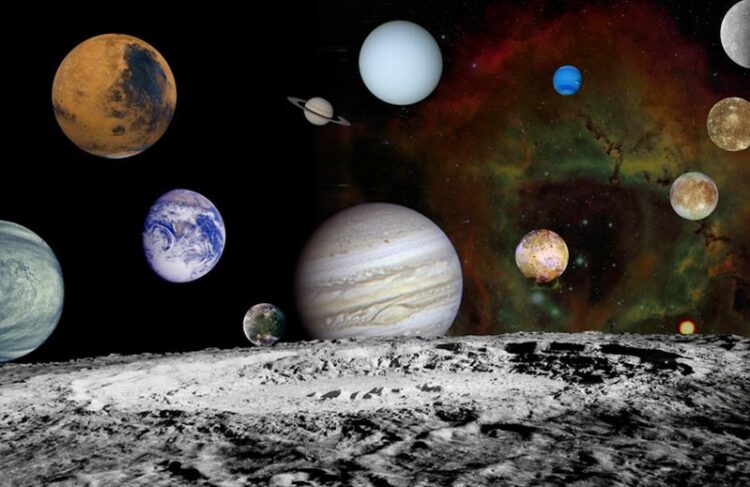The planet that could end life on Earth

Solar system montage of the nine planets and moons of Jupiter in our solar system.
Credit: NASA/JPL/ASU
Experiment demonstrates solar system’s fragility.
A terrestrial planet hovering between Mars and Jupiter would be able to push Earth out of the solar system and wipe out life on this planet, according to a UC Riverside experiment.
UCR astrophysicist Stephen Kane explained that his experiment was meant to address two notable gaps in planetary science.
The first is the gap in our solar system between the size of terrestrial and giant gas planets. The largest terrestrial planet is Earth, and the smallest gas giant is Neptune, which is four times wider and 17 times more massive than Earth. There is nothing in between.
“In other star systems there are many planets with masses in that gap. We call them super-Earths,” Kane said.
The other gap is in location, relative to the sun, between Mars and Jupiter. “Planetary scientists often wish there was something in between those two planets. It seems like wasted real estate,” he said.
These gaps could offer important insights into the architecture of our solar system, and into Earth’s evolution. To fill them in, Kane ran dynamic computer simulations of a planet between Mars and Jupiter with a range of different masses, and then observed the effects on the orbits of all other planets.
The results, published in the Planetary Science Journal, were mostly disastrous for the solar system. “This fictional planet gives a nudge to Jupiter that is just enough to destabilize everything else,” Kane said. “Despite many astronomers having wished for this extra planet, it’s a good thing we don’t have it.”
Jupiter is much larger than all the other planets combined; its mass is 318 times that of Earth, so its gravitational influence is profound. If a super-Earth in our solar system, a passing star, or any other celestial object disturbed Jupiter even slightly, all other planets would be profoundly affected.
Depending on the mass and exact location of a super-Earth, its presence could ultimately eject Mercury and Venus as well as Earth from the solar system. It could also destabilize the orbits of Uranus and Neptune, tossing them into outer space as well.
The super-Earth would change the shape of this Earth’s orbit, making it far less habitable than it is today, if not ending life entirely.
If Kane made the planet’s mass smaller and put it directly in between Mars and Jupiter, he saw it was possible for the planet to remain stable for a long period of time. But small moves in any direction and, “things would go poorly,” he said.
The study has implications for the ability of planets in other solar systems to host life. Though Jupiter-like planets, gas giants far from their stars, are only found in about 10% of the time, their presence could decide whether neighboring Earths or super-Earths have stable orbits.
These results gave Kane a renewed respect for the delicate order that holds the planets together around the sun. “Our solar system is more finely tuned than I appreciated before. It all works like intricate clock gears. Throw more gears into the mix and it all breaks,” Kane said.
Journal: The Planetary Science Journal
DOI: 10.3847/PSJ/acbb6b
Method of Research: Computational simulation/modeling
Article Title: The Dynamical Consequences of a Super-Earth in the Solar System
Article Publication Date: 28-Feb-2023
Media Contact
Jules Bernstein
University of California – Riverside
Jules.Bernstein@ucr.edu
Office: United States
All latest news from the category: Physics and Astronomy
This area deals with the fundamental laws and building blocks of nature and how they interact, the properties and the behavior of matter, and research into space and time and their structures.
innovations-report provides in-depth reports and articles on subjects such as astrophysics, laser technologies, nuclear, quantum, particle and solid-state physics, nanotechnologies, planetary research and findings (Mars, Venus) and developments related to the Hubble Telescope.
Newest articles

Pinpointing hydrogen isotopes in titanium hydride nanofilms
Although it is the smallest and lightest atom, hydrogen can have a big impact by infiltrating other materials and affecting their properties, such as superconductivity and metal-insulator-transitions. Now, researchers from…

A new way of entangling light and sound
For a wide variety of emerging quantum technologies, such as secure quantum communications and quantum computing, quantum entanglement is a prerequisite. Scientists at the Max-Planck-Institute for the Science of Light…

Telescope for NASA’s Roman Mission complete, delivered to Goddard
NASA’s Nancy Grace Roman Space Telescope is one giant step closer to unlocking the mysteries of the universe. The mission has now received its final major delivery: the Optical Telescope…



